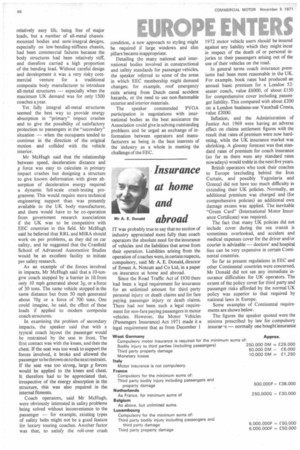Coach design and safety
Page 49

Page 50

If you've noticed an error in this article please click here to report it so we can fix it.
SOME of the problems — and associated development costs — in changing from composite wood-and-metal to all-metal structures for coaches, and especially integral designs, were explained by Mr John McHugh, director of engineering of the Duple Group, in a paper on coach design and safety.
The present UK technique was to build metal, wood and plastic bodies with lightly stressed panels and relatively large windows and mount these on separately framed vehicle chassis. By contrast, in the EEC structures were all-metal, mainly steel, in semi-integral or fully integral assemblies having stressed-panel outer skins. The semi-integral designs used a separately framed chassis but in the fully integral design there was no main chassis, so the structure had to be capable of carrying the passengers and associated payload in addition to the loadings imposed by suspension, steering, power-phint and transmission.
For a whole variety of reasons, said Mr McHugh, the progressive development of the UK body manufacturer from composite to integral techniques of manufacture would require a new set of design parameters and commercial considerations. The effect of deterioration of the structure by fatigue, corrosion or small impact damage might become very important in safety inspection procedures. The introduction of the more sophisticated fully integral structures would tend to demand longer design and development testing periods and there would need to be an assurance that the much higher tooling costs did not carry into service consequential higher warranty and service policy claims against designs which might not have been proved for high durability. It was also possible that impact crashes could demand new repair techniques which might not be easily available in the UK.
Fully integral designs were better than composite vehicles in coping with the effects of impact crashes, especially where the structure had energy-absorbing characteristics. But integral all-metal structures were very demanding in design and development "know-how". On coaches with conventional chassis the body had a relatively easy life, being free of major loads, but a number of all-metal chassis mounted bodies and semi-integral designs, especially on low-bending-stiffness chassis, had been commercial failures because the body structures had been relatively stiff, and therefore carried a high proportion of the bending load. Without careful design and development it was a very risky commercial venture for a traditional composite body manufacturer to introduce all-metal structures — especially when the maximum UK demand was for only 1500 coaches a year.
Yet : fully integral all-metal structures seemed the best way to provide energy absorption in "primary" impact crashes and to give the possibility of satisfactory protection to passengers in the "secondary" situation — when the occupants tended to continue in the direction of the original motion and collided with the vehicle interior.
Mr McHugh said that the relationship between speed, deceleration distance and g force was easy to calculate in primary impact crashes but designing a structure to give known deformation with given absorption of deceleration energy required a dynamic full-scale crash-testing programme. This would require more technical engineering support than was presently available to the UK body manufacturer, and there would have to be co-operation from government research associations if the UK was to be competitive with EEC countries in this field. Mr McHugh said he believed that RRL and MIRA should work on psv problems, as they did on car safety, and he suggested that the Cranfield School of Advanced Automotive Studies would be an excellent facility to initiate psv safety research.
As an example of the forces involved in impacts, Mr McHugh said that a 10-tongvw coach stopped by a barrier in lft from only 10 mph generated about 3g, or a force of 30 tons. The same vehicle stopped in the same distance but from 50 mph generated about 70g or a force of 700 tons. One could imagine, he said, the effect of these loads if applied to modern composite coach structures.
In examining the problem of secondary impacts, the speaker said that with a typical coach layout the passenger would be restrained by the seat in front. The first contact was with the knees, and then the chest. If the seat was too weak to support the forces involved, it broke and allowed the passenger to be thrown on to the next restraint_ If the seat was too strong, large g forces would be applied to the knees and chest. It therefore had to be appreciated that, irrespective of the energy absorption in the structure, this was also required in the internal fitments.
Coach operators, said Mr McHugh, were obviously interested in safety problems being solved without inconvenience to the passenger — for example, existing types of safety belts might not be a good feature for luxury touring coaches. Another factor was that, to satisfy the roll-over crash condition, a new approach to styling might be required if large windows and slim pillars became inappropriate.
Detailing the many national and international bodies involved in constructional and safety standards for passenger vehicles, the speaker referred to some of the areas in which EEC membership might demand changes; for example, roof emergency exits arising from Dutch canal accident hazards, or the need to use non-flammable exterior and interior materials.
The speaker commended PVOA participation in negotiations with international bodies as the best assistance the Association could give in solving outstanding problems and he urged an exchange of information between operators and manufacturers as being in the best interests of the industry as a whole in meeting the challenge of the EEC.




































































































































































